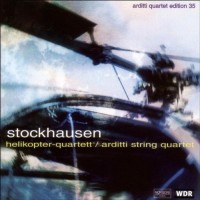Karlheinz Stockhausen’s Helicopter Quartet
|
[See also related Stockhausen Helicopter articles by Walt Mundkowsky and Grant Chu Covell.] Mike Silverton [April 2000. Originally appeared in La Folia 2:4.] Those dear, dead salad days! I think we can agree that high fidelity acquired its allure in the Fifties, buoyed by the long-playing disc. High-end salons were yet to appear. One visited corners in electronics emporia, sometimes in rooms with doors that actually closed, where the wide-eyed tyro thrilled to the wonders within narrow grooves. Flashy sounds usually, lots of percussion, open-reel tapes if one was lucky. Classical, jazz, island steel bands…. My favorite locale, a neighborhood in downtown Manhattan long since razed for the World Trade Center, is where I bought at Leonard Radio a fifteen-inch Tannoy dual-concentric speaker in a corner bass-reflex enclosure — the Windsor, if memory serves. My former father-in-law, an attorney, represented the business interests fighting the order to vacate. It was a wonderful district aburst with techno-trifles and fascinating souvenirs. In a used-electronics shop window I actually saw a Norden bombsight, a top-secret weapon of WW2. A big thing draped in dials it was, behind grimy glass. I still regret not asking the price. Would have made one hell of a make-believe line conditioner. Probably get me elected president of some audiophile club. Hi-fi’s only domestic competition, tubby radio-console phonographs, in no way achieved the big, lifelike sounds of a good component system. (One could have buried a rhinoceros in those majestic speaker enclosures!) As surely as form follows function, software follows hardware’s lead. Where’s the purpose in dropping a bundle on a truckload of gear absent a strut for friends and relations? Thus the appearance of sound spectaculars, mostly musical — large pipe organs enjoyed a vogue — and some few novelties: locomotives, racing cars, just about anything that makes a big noise. Not that the promise of sonic thrills and chills ever quite disappeared. Swedish BIS CDs used to carry an alert regarding dynamics as possibly hazardous to one’s system’s future. I did manage to fry an amp with a Denon CD of Mahler’s Sixth, Inbal conducting. Within the insert we see the warning concerning the last movement’s “hammer blows of fate,” one of which indeed proved fatal, with fireworks in miniature. Why the memories? An Auvidis Montaigne CD calls them to mind. Don’t get me wrong. There’s nothing in the least meretricious about Karlheinz Stockhausen (but mystical most certainly and another story altogether). The man is widely acknowledged one of the European avant garde’s principal and most dignified figures, yet whose oeuvre I would hesitate to recommend to the generalist as probably too outré. I do, however, recommend this release to the audiophile who, like me, reverts to the raucous as a nice change of pace. Helicopter Quartet calls to mind the exuberance of hi-fi’s youth. The work in live performance, of which this CD is a studio re-creation, shares features of a Blitzkrieg, Super Bowl halftime show and an Olympics opening ceremony. Here’s the picture, or better, panorama. The piece requires four helicopters (for the 1995 event, the Austrian army’s), 12 audio and four video transmission channels. The four string players are introduced by a moderator whom the composer allows may also be the sound projectionist. The players walk or are driven to the helicopters, cameramen at their heels. From the notes: Each … player and his helicopter is transmitted via camera, TV transmitter, three microphones and sound transmitters to his own group of monitors for the audience [in the concert hall]. Each … player should be constantly audible and always visible close up — face, hands, bow, instrument … without any camera changes, [fades] or other pictures. … The ascent lasts about five minutes. … The microphone transmission from each helicopter should be such that the sounds of the rotor blades and that of the instrument blend well, and the instrument is heard slightly louder. … [One] microphone in front of the mouth of the player, and [one] microphone outside the helicopter which clearly picks up the sounds and rhythms of the rotor blades [all italics Stockhausen’s]. Und so weiter. Microphones for mouths because the players also vocalize, mostly reciting numbers in German. The helicopters circle the venue, varying their altitudes. “They should fly so high that the direct sound of the … blades is much softer than the sound coming from the loudspeakers, or even better, inaudible.” Stockhausen has been for years a great proponent and innovator of electronic music. “After landing, cameras follow the … players and … pilots as they disembark … and walk to the concert hall” where they answer questions from the audience, doubtless straight-faced. A Teutonic event. Thoroughness über alles. But we envision little of these strictly programmed aspects on CD, where the violins, rotors and occasional utterances meld to an event you’re free to play as lustily as the spirit suggests, since what one hears string-quartetwise relates not to life but to amplification in situ. One sets his level at helicopter-in-the-backyard gratification. Chuffa chuffa chuffa chuf! — memory lane!
[More Mike Silverton, Vol. 2, No. 4]
[More
Stockhausen]
[Previous Article:
Dear La Folia 2.]
[Next Article:
Helicopter String Quartet]
|
